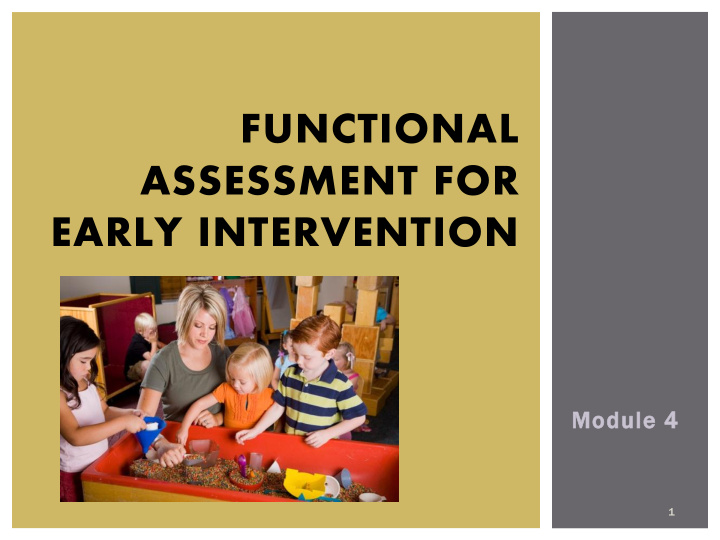



FUNCTIONAL ASSESSMENT FOR EARLY INTERVENTION Module 4 1
INTRODUCTIONS Who am I? Who are you? Expectations Syllabus Change- Module 4 quiz due 2/10/13 2
CLASS FORMAT Best Practices in Instruction Data Based Decision Making 3
GREAT BEHAVIOR GAME http://www.educatorshandbook.com/pro ducts/game/ Game Options Game Rules Game Data Rewards 4
TIME TO BREAK INTO GROUPS Group #1 Group #3 Emma Kelly Lyndsie Rachel Stephanie Andrea Lisa Anthony Group #2 Group #4 Sarah H. Colleen Kathryn Kimberly Emily Sarah L. Margaret Dave 5
DATA BASED DECISION MAKING: GUIDING TODAY’S INSTRUCTION http://www.surveymonkey.com/MySurvey _Responses.aspx?sm=jySKtkU9j7yI74SYP %2fj6F5ATyFabIUvCjLbipZn6qvQ%3d Data Analysis Different ways to group based off of data 6
COURSE REVIEW: ACTIVITY 1 st st time around- Write a comment or question on the corresponding chart paper for Modules 1-3 State a key point of the module Question remaining from the module An “ah ha” moment Something you want to see in practice Something you want to do in practice 2 nd nd time around- Respond to questions or comments already written 7
PLANS FOR MODULE 4 This week- Focus on the different types of data collection, advantages and disadvantages of each, and practice using them During the week- Observe in the classrooms Next week- Connecting the data to assist in determining the function of the behavior and intervention design 8
MODULE 4.1 FUNCTIONAL ASSESSMENT FOR EARLY INTERVENTION: OBJECTIVES At the end of this module, you will be able to (a) plan and apply functional assessments for improving learning environments for young children; (b) describe key framework of problem solving language and social behavior as early intervention targets; and (c) describe key steps in creating professional roles with families . 9
SOCIAL VALIDITY REVIEW FROM ABA Social Validity for Early Interventions Parents, teachers, agency agree on: Goals Methods Outcomes 10
FUNCTIONAL BEHAVIORAL ASSESSMENT IN EARLY CHILDHOOD SETTINGS (NIELSEN & MCEVOY, 2004) Problem behavior occurs for a reason Review functions of behavior Methods used to hypothesize function Many children referred for consultation have more than one concerning behavior 11
REVIEW OF HYPOTHESES AND FUNCTIONS OF CHALLENGING BEHAVIOR Child doesn’t have skills? Child isn’t motivated? Behavior is related to acquiring attention? Behavior is related to acquiring objects? Behavior is related to escaping a situation? Self-stimulatory: : The behavior serves the purpose of providing the child with sensory input, such as repetitive movements 12
WHAT & HOW TO ASSESS? Selected variables from research Child development Curriculum Prevention Keystone variable examples: compliance, functional communication, practice opportunities Functional behavioral assessment (FBA) ) Identifying the events in the environment that consistently precede and follow challenging behavior Functions and multiple functions Functional analysis for more severe challenges Selected functional assessment techniques Waking day interviews & scatter plot Narrative real time observations and ABC recording 13
KEYSTONE VARIABLES (BARNETT, BAUER, EHRHARDT, LENTZ & STOLLAR, 1996) Narrow target with widespread positive consequences • Functional Language Early Literacy • Social behaviors • Self-regulation • • Empirically based & individually determined 14
FUNCTIONAL ASSESSMENT FOR EARLY INTERVENTION: PROBLEM SOLVING INTERVIEW Problem Solving Interview: Problem Identification Problem Analysis Plan Development Plan Implementation Plan Evaluation 15
PROBLEM SOLVING INTERVIEW A Sample Problem Solving Interview (there are many variations) 1. The purpose of this interview is….? 2. Your greatest areas of difficulty are…? 4. Which bothers you the most? 5. How serious a problem is this? 5. How often? How long? Increasing? Decreasing? Episodic? 6. Exactly what does _____ do when acting this way? What would you like to see? 7. What triggers the activity? Intensifies it? Alleviates it? 8. Perceptions of origins? Effects on teaching (or parenting)? 9. What have you tried? 10. What are your goals and expectations? 11. What could be most easily managed or where would you like to start? 12. Summary of next steps (e.g., measuring, planning interventions, other) 16
WAKING DAY (AND SLEEP) INTERVIEW To identify a child’s typical day and planned activities Parent interview Teacher interview 17
INTERVIEW PRACTICE Within your group review the interview questions What type of information would you gain from an interview like this? Advantages? Disadvantages? Any questions about how this may look in the preschool setting? 18
SCATTER PLOT How to use a scatter plot As a group discuss advantages and disadvantages to using this method 19
SCATTER PLOT EXAMPLE 20
NARRATIVE REAL TIME (NRT) To help determine what to measure Can use early in consultations with confidence How to do NRT Switch to specific code as variables are clarified and defined 21
NARRATIVE REAL TIME EXAMPLE 22
PRACTICE NRT OBSERVATION http://www.youtube.com/watch?v=Ftmy2- feEvw Practice writing or typing an NRT observation of the teacher. Within your group discuss what was captured through this observation. What did you like about this method? What didn’t you like about this method? 23
THE ABC ANALYSIS: ANTECEDENTS-BEHAVIOR- CONSEQUENCES How to do an ABC analysis A B C 24
THE ABC ANALYSIS EXAMPLE A B C 8am None Aggression Positive observed towards teacher Entering (possible teacher and attention classroom home or peer transportatio n setting event) 8:15 Teacher Target child Positive quietly tries to run teacher Transition to suggests to from class; attention group circle children to other children (verbal & time come to do not physical) in circle transition to gently group preventing child from 25 running
PRACTICE http://www.youtube.com/watch?v=wxFszrJqLJo 26
GROUP ACTIVITY AND PRACTICE OBSERVATIONS Group #1 and Group #2- Observe using the ABC or NRT (1/2 each) Group #3 and Group #4- Work on Professional Role Activity Then we will switch! 27
PROFESSIONAL ROLES WITH CULTURALLY DIVERSE FAMILIES- ACTIVITY Culturally Diverse Families: Enhancing Home- School Relationships (Jones, 2010) Characteristics of Responsive Environments Key Strategies to Enhance Collaboration 28
PERMANENT PRODUCTS This is way to gather data by having something to show for it: Writing letters Check list of tasks Sticker chart Gluing patterns Teacher collected Can you think of other preschool examples? 29
REFLECTION Thoughts on classroom management How can it be modified for the preschool setting? Post-Test 30
Recommend
More recommend